Red light therapy supercharges your circulation by triggering the release of nitric oxide, a natural compound that relaxes and widens your blood vessels. When specific wavelengths of red and near-infrared light penetrate your skin, they activate your cells to produce more of this powerful vasodilator, enhancing blood flow throughout your body. This increased circulation delivers more oxygen and nutrients to your tissues while boosting cellular energy production through improved mitochondrial function. You'll experience better muscle recovery, enhanced healing, and improved cardiovascular health. There's much more to discover about how this remarkable therapy transforms your body at the cellular level.
The Nitric Oxide Connection
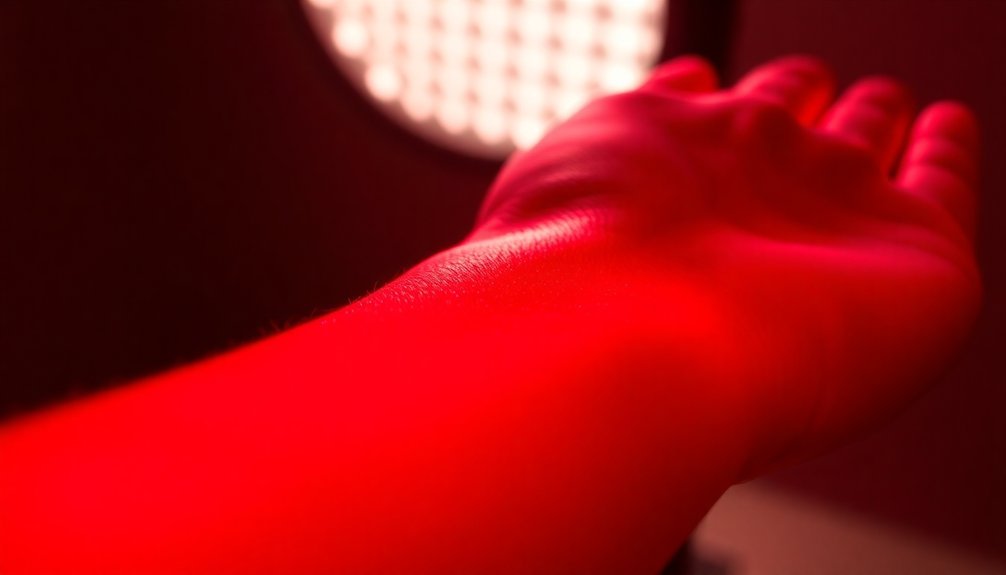
Blood circulation's silent hero, nitric oxide (NO), plays a fundamental role in maintaining cardiovascular health. When your body produces NO, it triggers your blood vessels to relax and widen, creating a natural pathway for enhanced blood flow throughout your system. This process, known as vasodilation, helps regulate your blood pressure and prevents serious cardiac conditions like strokes and heart attacks. NO is synthesized naturally through L-arginine conversion in your body.
Red light therapy works directly with your body's natural NO production mechanisms. When you're exposed to red light, it stimulates the release of NO from your cells, leading to immediate improvements in blood circulation.
You'll benefit from enhanced oxygen delivery to your tissues and better nutrient distribution throughout your body.
The effects don't stop there. As your NO levels increase, you'll experience improved exercise performance due to better oxygen delivery to your muscles. Your brain function may enhance from increased blood flow, and you'll support your body's natural wound healing processes.
What's particularly impressive is that the circulation-boosting effects of red light therapy can last for several hours after your treatment, making it an effective tool for maintaining healthy blood flow throughout your day.
Light Waves Meet Blood Flow
When you undergo red light therapy, specific wavelengths penetrate your skin and activate blood vessels through targeted cellular stimulation.
You'll experience improved circulation as the light triggers nitric oxide production, which naturally widens your blood vessels and increases blood flow.
The gentle warming effect of red light therapy expands your tiny capillaries, allowing more oxygen and nutrients to reach previously restricted areas of your body. This enhanced delivery system helps prevent chronic diseases while maintaining proper pH levels throughout your system.
Wavelengths Activate Blood Vessels
Through the intricate dance of light and biology, red therapy wavelengths trigger a remarkable cascade of events in your blood vessels. When 670nm red light penetrates your tissue, it stimulates the release of crucial nitric oxide precursors, causing your blood vessels to dilate naturally. This vasodilation doesn't just happen briefly – it maintains increased blood flow for at least 30 minutes after your treatment. The light therapy promotes vascular endothelial growth to form new blood vessels, supporting long-term circulatory health.
You'll experience enhanced circulation as your widened blood vessels allow for better oxygen delivery throughout your body. The red light activates your cells' mitochondria, boosting their energy production and oxygen consumption. This increased cellular activity supports tissue repair and regeneration, while the improved blood flow delivers essential nutrients to areas that need healing.
If you're dealing with circulation-related conditions like peripheral artery disease, diabetic neuropathy, or Raynaud's disease, you'll find red light therapy particularly beneficial. It's also effective for muscle recovery and managing chronic venous insufficiency.
Your body's enhanced microcirculation helps reduce inflammation and promotes healing in areas with compromised blood flow, making it easier for your cardiovascular system to function effectively.
Nitric Oxide Powers Flow
Every time you undergo red light therapy, a remarkable chemical reaction occurs as the light waves trigger your body's natural production of nitric oxide. This powerful molecule acts as your body's natural vasodilator, widening your blood vessels and creating superhighways for oxygen and nutrients to reach your tissues.
When nitric oxide floods your system, it kickstarts a cascade of circulatory benefits that can transform your health. The therapy's ability to stimulate mitochondrial activity helps your cells produce more energy for optimal blood flow. You'll experience enhanced blood flow throughout your body, from your brain to your toes, while inflammation decreases and healing accelerates.
Here's how nitric oxide powers your circulation during red light therapy:
- Relaxes and expands your blood vessels, allowing blood to flow more freely and reducing blood pressure
- Enhances microcirculation in your smallest blood vessels, ensuring oxygen reaches every cell
- Boosts your exercise performance by delivering more nutrients to your working muscles
- Supports cellular repair and reduces inflammation, speeding up healing processes
The increased nitric oxide production doesn't just improve your circulation – it's also crucial for managing various health conditions, from peripheral neuropathy to chronic venous insufficiency, making red light therapy a powerful tool for vascular health.
Heat Expands Tiny Capillaries
The powerful combination of heat and light waves in red therapy creates an additional circulatory boost beyond nitric oxide production.
When your body experiences heat stress, your blood vessels naturally dilate, allowing more blood to flow through your capillaries – the tiniest vessels in your circulatory system.
As red therapy warms your tissues, it triggers whole-body heat responses that increase blood perfusion throughout your legs and deep tissues. This expansion isn't just surface-level; it affects your entire vascular network, from major arteries to the smallest capillaries.
The deep venous system becomes particularly active, helping return blood more efficiently to your heart.
What makes red therapy especially effective is how light waves interact with your blood cells. The infrared wavelengths penetrate deep into your tissues, improving microcirculation where it matters most.
Your cells receive more oxygen and nutrients thanks to this enhanced blood flow, while your mitochondria get an energy boost that speeds up cellular repair.
This combined effect of heat expansion and light penetration creates measurable improvements in your circulation, which is why red therapy has become a valuable tool for treating various circulatory issues, including peripheral artery disease.
Vessels Expand With Red Light
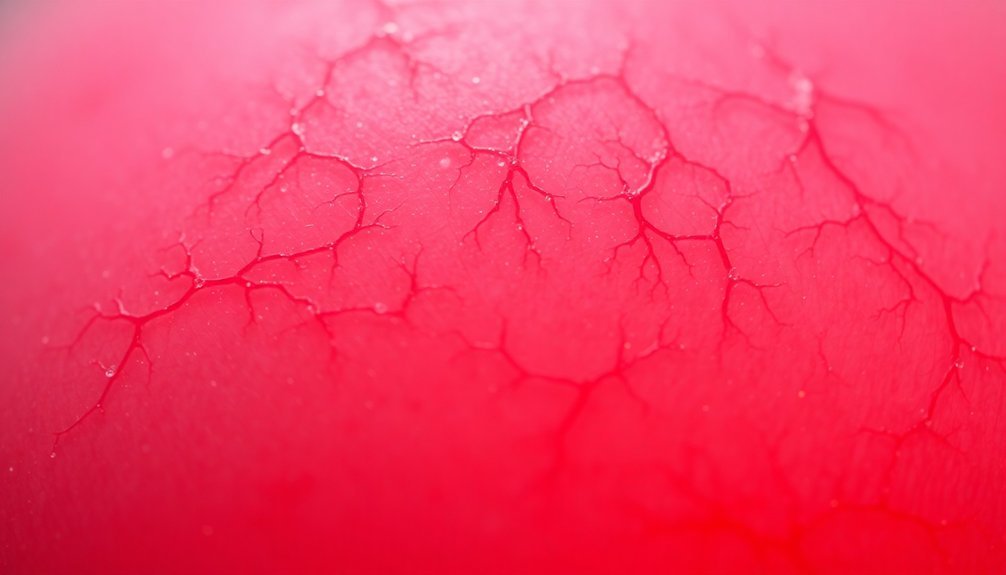
Blood vessels respond dramatically to red light therapy through a process called vasodilation. When red light penetrates your tissues, it triggers the production of nitric oxide, a vital molecule that signals your blood vessels to relax and widen. This natural process enhances blood flow throughout your body, delivering more oxygen and nutrients to your tissues.
The expansion of your blood vessels through red light therapy creates a cascade of beneficial effects:
- Your mitochondria become more active, producing additional energy that supports vessel dilation and overall vascular health
- Your endothelial cells increase their production of nitric oxide, maintaining the vasodilation effect for improved circulation
- Your microcirculation improves dramatically, allowing better oxygen delivery to tiny capillaries and enhanced toxin removal
- Your body starts forming new blood vessels through angiogenesis, creating better circulation networks
You'll notice these effects particularly in areas where circulation is vital, such as your muscles during recovery or in peripheral tissues affected by poor blood flow.
The systemic benefits extend beyond local application, as improved vessel dilation contributes to better overall cardiovascular health and tissue repair throughout your body.
Powering Your Cellular Engine
Inside your cells, red light therapy works as a powerful catalyst for cellular energy production by targeting your mitochondria – the microscopic powerhouses responsible for generating ATP. When red and near-infrared light penetrates your tissues, it interacts with cytochrome c oxidase, a key enzyme in your mitochondria's electron transport chain, optimizing your cellular energy production.
You'll experience enhanced ATP production as the therapy stimulates both existing mitochondria and promotes the creation of new ones. This process, known as mitochondrial biogenesis, maintains your cells' consistent energy supply. The therapy also prevents nitric oxide from interfering with energy production, allowing your mitochondria to function at peak efficiency.
What's particularly remarkable is how red light therapy triggers a beneficial hormetic response in your cells. This mild stress actually strengthens your cellular resilience, reducing inflammation and oxidative stress.
As your mitochondrial function improves, you'll notice enhanced energy metabolism, better muscle performance, and improved recovery. The therapy's ability to penetrate deep into your tissues guarantees these benefits reach cells throughout your body, supporting thorough circulatory health and cellular repair processes.
Heart Health Through Light
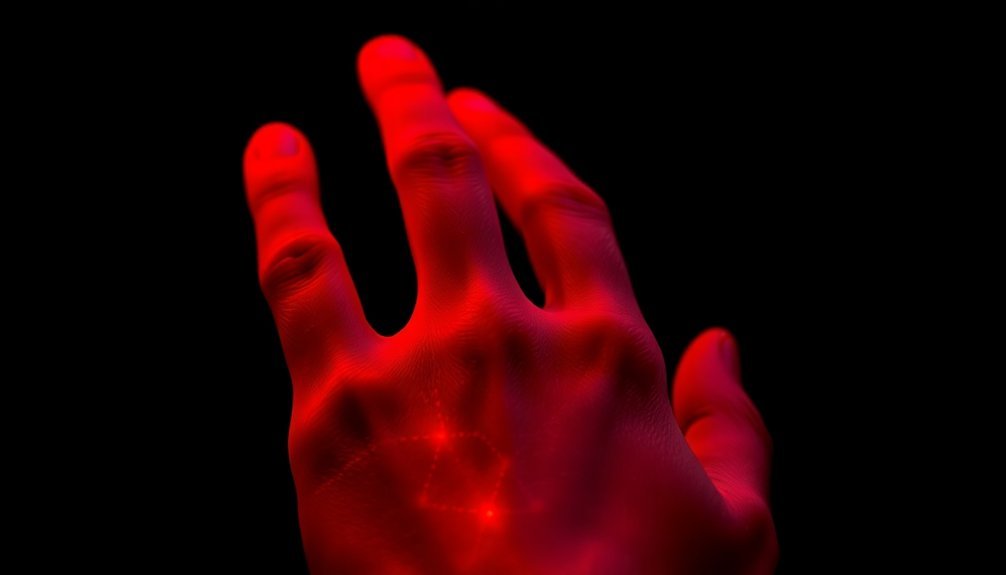
Your heart's ability to function efficiently relies heavily on healthy mitochondria, which red light therapy effectively supports by boosting cellular energy production.
Through increased nitric oxide production, red light therapy improves your blood flow and circulation, making it easier for oxygen and nutrients to reach essential tissues throughout your body.
Research shows that red light therapy can help protect against heart failure by reducing inflammation and supporting cardiac function, offering a promising approach to maintaining cardiovascular health.
Mitochondrial Power For Hearts
At the heart of cellular energy production lies a fascinating powerhouse: the mitochondria. These tiny cellular components are essential for your cardiovascular health, as they generate the ATP your heart needs to maintain its relentless rhythm.
When your mitochondria aren't functioning effectively, your heart cells struggle to produce enough energy, leading to increased oxidative stress and potential cardiovascular problems.
Red light therapy directly targets and enhances your mitochondrial function through these key mechanisms:
- It stimulates the electron transport chain in your mitochondria, boosting ATP production and providing more energy for your heart cells
- It reduces harmful reactive oxygen species (ROS), protecting your cardiovascular system from oxidative damage
- It promotes mitochondrial biogenesis, helping your cells create new, healthy mitochondria
- It enhances cellular respiration efficiency, improving your heart's energy production process
You'll find that when your mitochondria are performing at their peak, your cardiovascular system benefits substantially. This improved mitochondrial function means better heart contractility, reduced inflammation, and enhanced overall cardiovascular health.
Nitric Oxide Boosts Flow
Nitric oxide emerges as a powerful molecule in your cardiovascular health, acting as a natural vasodilator that relaxes and widens blood vessels throughout your body. When you expose yourself to red light therapy, you'll trigger increased production of this crucial compound, enhancing blood flow and improving circulation throughout your system.
Your body's response to this boost in nitric oxide production is remarkable. You'll experience enhanced blood vessel dilation, which allows more oxygen and nutrients to reach your tissues. This improved circulation doesn't just lower your blood pressure – it also helps prevent cardiovascular diseases by strengthening your endothelial function and reducing platelet aggregation.
Red light therapy's ability to stimulate nitric oxide release creates a cascade of health benefits. You'll notice improved muscle recovery after exercise, enhanced wound healing, and better overall tissue repair.
The therapy's effects on microcirculation are particularly significant, as it boosts blood flow in your smallest vessels and capillaries. This increased perfusion helps reduce inflammation, combat infections, and support your body's natural healing processes.
For superior cardiovascular health, you're fundamentally giving your circulatory system a powerful upgrade through this natural, light-based intervention.
Light Against Heart Failure
Beyond its circulation-boosting effects, red light therapy shows remarkable promise in protecting against heart failure and cardiac damage. Research reveals that intense light exposure activates the PER2 gene, which helps shield your heart from damage during cardiac events. This breakthrough could revolutionize how we protect patients before high-risk surgeries and manage heart conditions.
When you receive photobiomodulation (PBM) therapy, your heart experiences several beneficial changes that can improve your cardiac health:
- Your left ventricular mass decreases while ejection fraction improves, leading to better overall heart function
- Your cardiac adenosine levels increase, helping regulate blood flow more effectively
- Your mitochondrial metabolism enhances, reducing potential cardiac damage
- Your perivascular fibrosis and inflammation decrease, combating diastolic dysfunction
You'll find these benefits particularly noteworthy if you're concerned about age-related heart issues, as PBM therapy has shown promising results in slowing cardiovascular aging.
The therapy's ability to enhance blood circulation while reducing inflammation makes it a powerful tool against heart failure. While researchers continue optimizing specific wavelengths and intensities for maximum effectiveness, current evidence suggests that long-term exposure to low-dose near-infrared light could substantially benefit your heart health and longevity.
Athletic Performance And Recovery
Professional athletes and fitness enthusiasts increasingly turn to red therapy as a powerful tool for maximizing athletic performance and speeding up recovery.
When you use red therapy, it enhances your muscle function by boosting cellular energy production and strengthening tissue resistance to strains and tears.
You'll notice improved endurance as red therapy stimulates your mitochondria, leading to increased ATP production. It also optimizes your blood flow, ensuring your muscles receive the oxygen and nutrients they need for peak performance.
This enhanced circulation helps remove toxins and waste products that can slow you down.
What's particularly beneficial is red therapy's impact on recovery. You'll experience reduced muscle soreness after intense workouts due to its anti-inflammatory effects at the cellular level.
It accelerates healing by enhancing cellular repair and regeneration, getting you back to training faster.
The best part? You can safely use red therapy daily, either before or after your workouts. Whether you're a strength athlete or focus on endurance training, you'll find it's an effective addition to your routine, especially when combined with proper nutrition and other recovery methods.
Healing From The Inside Out
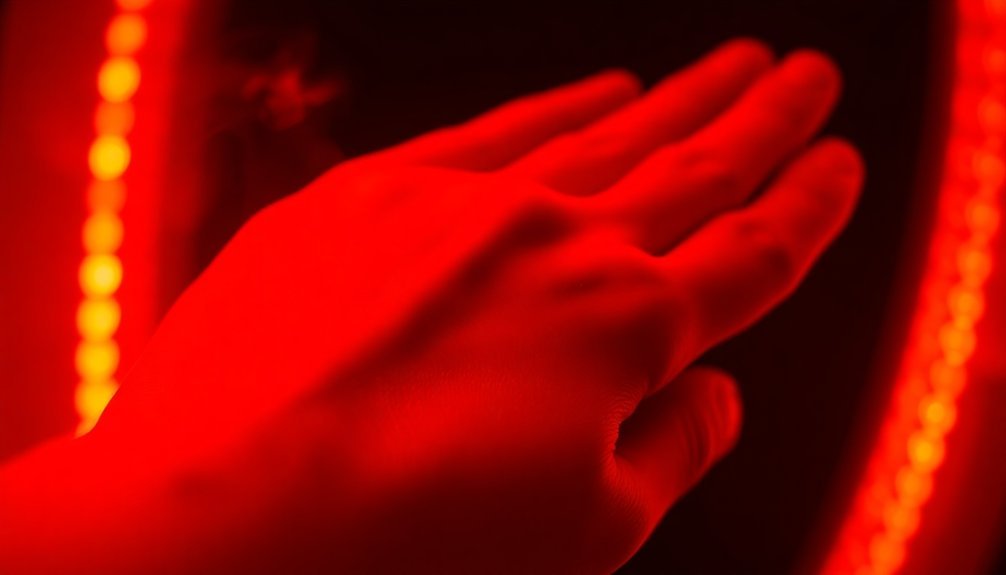
Your body's remarkable healing abilities get a powerful boost from red light therapy through its cellular repair activation and blood flow enhancement.
When red light penetrates your tissues, it triggers increased nitric oxide production, causing your blood vessels to widen and deliver more oxygen and nutrients to damaged areas.
This enhanced circulation, combined with the therapy's stimulation of cellular repair mechanisms, helps your body heal more efficiently from the inside out.
Cellular Repair Activation
The remarkable process of cellular repair activation serves as the cornerstone of red light therapy's healing benefits. When you expose your body to red light, it triggers a cascade of cellular responses that supercharge your body's natural repair mechanisms.
Your mitochondria, the powerhouses of your cells, become energized and produce more cellular energy, which is essential for healing and regeneration.
Red light therapy doesn't just stop at energy production – it creates a thorough healing environment within your body. Here's how the cellular repair activation process unfolds:
- Your cells' mitochondria absorb the red light wavelengths, boosting ATP production and increasing cellular energy levels
- The enhanced energy production activates sirtuins, which regulate cellular health and repair processes
- Stem cells receive signals to transform into specialized cells, replacing damaged tissue more efficiently
- Your blood circulation improves, delivering crucial nutrients and removing inflammatory mediators
This cellular repair activation process works even as you age, though natural repair mechanisms slow down. By consistently using red light therapy, you're supporting your body's innate healing abilities and maintaining ideal cellular function, despite factors like aging or environmental stressors that might otherwise impair regeneration.
Blood Flow Enhancement
While cellular repair activation provides the foundation for healing, enhanced blood flow serves as the essential delivery system that maximizes red light therapy's benefits. When you undergo red light therapy, it triggers the production of nitric oxide, which naturally dilates your blood vessels and improves circulation throughout your body.
This enhanced blood flow doesn't just affect major vessels – it substantially improves microcirculation in your smallest blood vessels, delivering critical oxygen and nutrients to areas that might otherwise receive poor circulation. You'll experience reduced inflammation, which often restricts blood flow, allowing for better healing and recovery in damaged tissues.
To maximize these circulation benefits, you can combine red light therapy with other proven methods. Regular physical activity, particularly aerobic exercise, complements RLT by stimulating new capillary formation and improving vascular connections.
You'll want to maintain proper hydration and follow a balanced diet rich in anti-inflammatory foods to support healthy blood flow. Consider incorporating therapeutic techniques like massage or instrument-aided soft tissue work to further enhance circulation.
When you coordinate these approaches with red light therapy, you're creating ideal conditions for healing and recovery.
Beyond Surface Level Benefits
Beneath visible skin improvements lies a complex network of cellular changes triggered by red light therapy. When you undergo red light therapy, you're activating deep cellular mechanisms that revolutionize your body's circulatory function.
The therapy stimulates nitric oxide production, which relaxes your blood vessels and enhances blood flow far beyond what's visible to the naked eye.
At the cellular level, red light therapy creates four essential changes:
- Your mitochondria become more efficient at producing energy, enabling better cellular repair and function throughout your body
- The inflammation in your blood vessels decreases substantially, allowing blood to flow more freely through your circulatory system
- Your microcirculation improves, meaning blood reaches previously underserved areas through tiny capillaries
- Your cells receive more oxygen and nutrients due to enhanced blood delivery systems
The benefits extend into your lymphatic system, improving drainage and reducing swelling. This thorough enhancement of your circulatory system doesn't just improve blood flow – it optimizes your entire body's function, from muscle recovery to immune response.
Your cells work more efficiently, heal faster, and maintain better overall health through these deep-tissue improvements.
Scientific Proof Behind Light Therapy
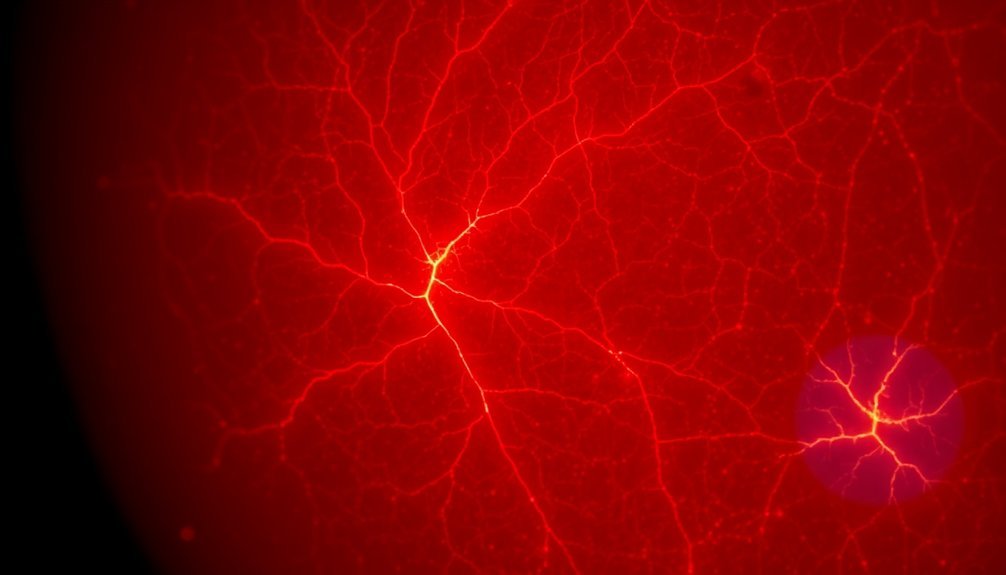
Substantial scientific evidence supports the remarkable benefits of red light therapy on circulation and cellular health. Research consistently demonstrates its ability to stimulate nitric oxide production, leading to vasodilation and improved blood flow throughout your body.
Studies have shown that when you undergo red light therapy, your mitochondria increase their energy production, enhancing your cells' repair and regenerative capabilities.
You'll find strong scientific backing for red light therapy's effectiveness in multiple areas. Clinical studies confirm its ability to boost collagen production, accelerate wound healing, and reduce inflammation.
The therapy's mechanisms of action have been well-documented, showing how it penetrates your tissue to stimulate cellular processes that promote healing and regeneration. Your blood vessels respond by widening, allowing for better oxygen and nutrient delivery to your cells.
While human studies continue to expand our understanding, existing research indicates that you can expect noticeable improvements in circulation, skin health, and pain management.
What's particularly compelling is that these benefits come with minimal risk of side effects when you follow proper treatment protocols, making it a safe option for improving your circulatory health.
Daily Practice For Better Circulation
To get the most out of red light therapy for circulation, you'll need to establish a consistent routine and follow proven protocols. The key is to commit to 10-20 minute sessions, 3-5 times weekly, while targeting areas where you're experiencing poor circulation, like your legs, feet, or hands.
For best results, you'll want to combine red light therapy with lifestyle practices that naturally boost your circulation. This means incorporating regular exercise, maintaining a healthy diet, and ensuring you're getting adequate sleep.
You can also enhance the therapy's effectiveness by pairing it with massage or other complementary treatments.
- Start with shorter sessions (10 minutes) and gradually increase duration as your body adjusts.
- Target specific areas where you notice poor circulation, keeping the light source close to your skin.
- Schedule your sessions at consistent times to build a sustainable routine.
- Monitor your progress and adjust intensity or duration based on your body's response.
Frequently Asked Questions
Can Red Light Therapy Interfere With Blood Pressure Medications?
Yes, you'll need to be careful with red light therapy if you're on blood pressure medications. It's best to consult your doctor, as some medications can cause photosensitivity and require a waiting period.
How Long Does Improved Circulation Last After One Red Light Session?
After one red light session, you'll experience improved circulation for several hours to days, but individual results vary. For lasting benefits, you'll need consistent treatments 3-5 times weekly over multiple months.
Is Red Light Therapy Safe During Pregnancy for Circulation Improvement?
You'll need your doctor's approval first, but red light therapy can safely improve circulation during pregnancy when used properly – just avoid direct abdominal exposure and always wear eye protection during sessions.
Can Red Light Therapy Help With Circulation in Diabetic Neuropathy?
Yes, red light therapy can substantially help your circulation if you have diabetic neuropathy. It'll increase blood flow, promote healing, reduce inflammation, and improve nerve function through enhanced oxygen and nutrient delivery.
Does Wearing Clothes During Red Light Therapy Reduce Circulation Benefits?
Yes, wearing clothes during red light therapy will reduce its circulation benefits. You'll get better results with direct skin exposure, as clothing creates a barrier that limits the light's ability to penetrate your tissues effectively.
In Summary
Red light therapy isn't just a passing trend – it's your ticket to better circulation from the inside out. You'll experience improved blood flow as nitric oxide levels increase and blood vessels dilate under red light wavelengths. By making it part of your daily routine, you're giving your cells the energy boost they need while supporting your cardiovascular health. It's time to harness the power of light for your circulatory wellness.

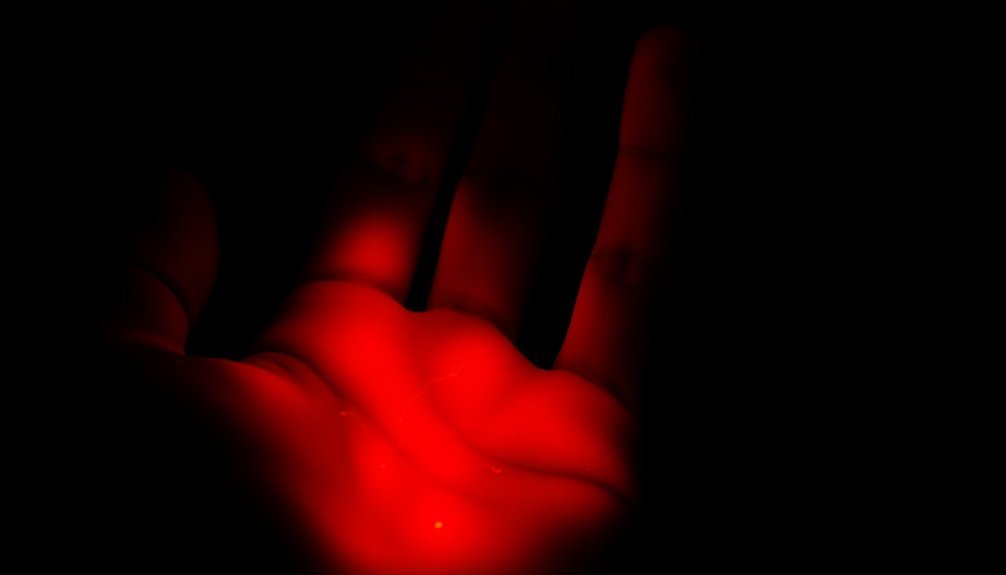



Leave a Reply